View in other NatureServe Network Field Guides
NatureServe
Montana
Utah
Wyoming
Idaho
Wisconsin
British Columbia
South Carolina
Yukon
California
New York
Flatleaf Bladderwort - Utricularia intermedia
State Rank Reason (see State Rank above)
Only known from a few occurrences in the western half of the state.
General Description
PLANTS: Perennial aquatic herbs with submerged stems, bladders, and overwintering buds. Plants are rootless. Bladders, which trap small aquatic animals for the plant's nourishment, are borne on separate specialized branches. Source: Lesica et al. 2012.
LEAVES: The plants have slender stems with numerous, crowded, finely dissected leaves. The leaves are mostly 0.5-2 cm long, flattened, and have several linear divisions all of about the same width and abruptly tapering or blunt at the tip. Source: Lesica et al. 2012.
INFLORESCENCE: An erect, few flowered bracteate raceme. 1 to 4 flowers are emergent, yellow, and snapdragon-like. Montana plants are often without flowers. Source: Lesica et al. 2012.
The specific epithet intermedia refers to this species’ intermediate size compared to others within the genus. Utricularia is derived from the Latin utriculus which translates to wineskin or leather bottle and refers to their sac-like bladders (Poppinga et al. 2016).
Phenology
Flowering in late July.
Diagnostic Characteristics
Montana has four
Utricularia species. They are all aquatic, submerged, rootless herbs with small bladder-like traps borne on branches or leaves. All species have emergent, snapdragon-like flowers borne on a scape. All have many, globose overwintering buds called turions.
Flatleaf Bladderwort –
Utricularia intermedia, native, SOC
*Size: Scape emerges 8-25 cm from the water.
*Bladders: 3-5 mm long and borne on separate leafless branches.
*Bladder Glands: Both arm-pairs generally diverge by 0–30 degrees (Rice 2012).
*Leaves: 5-20 mm long, palmately divided. Segments are flat with entire to obscurely serrate margins.
*Buds: 6-15 mm long.
*Flowers: 1-4 yellow flowers in the inflorescence. Each is 10-15 mm long with a 5-9 mm long spur.
*Fruit: Borne on erect pedicels when mature.
Greater Bladderwort –
Utricularia vulgaris, native and desirable
*Size: Scape emerges 10-40 cm from the water.
*Bladders: 2-5 mm long and only attached to leaf segments.
*Bladder Glands: Long arm-pair is parallel or diverges slightly. Short arm-pair diverges by 90–180 degrees (Rice 2012).
*Leaves: Pinnately divided and crowded. 20-50 mm long, entire and more or less round.
*Buds: 15-25 mm long.
*Flowers: More than 5 yellow flowers in the inflorescence. Each is 10-18 mm long with a 5-8 mm long spur.
*Fruit: Borne on curved pedicels when mature.
Lesser Bladderwort –
Utricularia minor, native and desirable
*Size: Scape emerges 5-10 cm from the water.
*Bladders: 1-3 mm long and occur only on leafy stems.
*Bladder Glands: Long arm-pair diverging slightly. Short arm-pair diverging by 270–300 degrees (so all 4 arms oriented in the same direction) (Rice 2012).
*Leaves: 2-8 mm long and palmately divided. Segments are flat with entire margins.
*Buds: 2-9 mm long.
*Flowers: 2-5 yellow flowers in an inflorescence. Each is 5-10 mm long with a 2 mm long spur.
*Fruit: Borne on curved pedicels when mature.
Northern Bladderwort –
Utricularia ochroleuca, native, SOC
*Size: Scape emerges up to 15 cm from the water
*Bladders: Most are borne on leafless stems but a few can often be found on leafy shoots.
*Bladder Glands: long arm-pair diverging by 20–45°, short arm-pair diverging by 40–160 degrees (Rice 2012)
*Leaves: 5-15 mm long and palmately divided. Terminal leaf segments with bristle tips and toothed margins.
*Buds: 2-3 mm and bristly
*Flowers: Inflorescence usually 3-5 flowered. Each is 8-11 mm long with a 10-15 mm long spur.
*Fruit: Borne on curved pedicels when mature.
Species Range
Montana Range
Range Descriptions
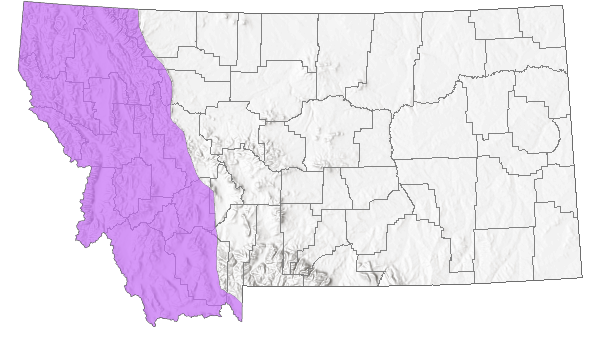
 Native
Native
Range Comments
Circumboreal; in North America occurs from Alaska to eastern Canada and south to California, northwestern Wyoming, North Dakota, Illinois, and Pennsylvania.
Observations in Montana Natural Heritage Program Database
Number of Observations: 19
(Click on the following maps and charts to see full sized version)
Map Help and Descriptions
Relative Density
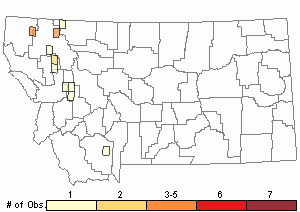
Recency
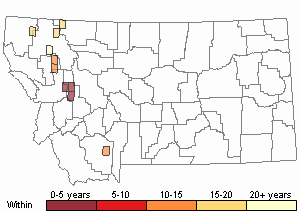

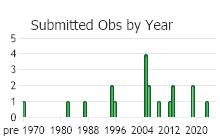
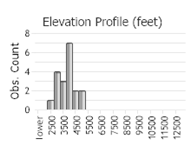 (Observations spanning multiple months or years are excluded from time charts)
(Observations spanning multiple months or years are excluded from time charts)
Habitat
Found in the valley to montane zones from 1200-2700m. In Montana it occurs in Sphagnum fens. Plants are inconspicuous, creeping on peat beneath shallow water and between emergent plants. (Lesica et al. 2012)
National Vegetation Classification System Groups Associated with this Species
Wetland and Riparian
Peatland
Ecology
Utricularia ochroleuca is most likely a hybrid of U. minor x U. intermedia (Rice 2012).
ASSOCIATED SPECIES
Species associated with Flatleaf Bladderwort include Hardstem Bulrush (Schoenoplectus acutus), other Bladderworts (Utricularia spp.), rushes (Juncus spp.), and sedges (Carex spp.) (Arnett 2011).
BLADDER FUNCTION
All Bladderwort species are carnivorous plants that use small bladder-like traps to capture and digest prey. Prey includes aquatic insect larvae, water mites, nematodes, gastropods, small tadpoles, crustaceans, diatoms, and other aquatic microorganisms (Mette et al. 2000). Each bladder has a valve that opens like a trap door when the surrounding trigger hairs are brushed (Poppinga et al. 2015). When the valve opens, a low pressure gradient causes water to flow quickly inside pulling in the organism that triggered the hairs (Singh et al. 2011). Glands found on the inside of the traps both digest prey through enzyme excretion, and absorb the nutrients after digestion (Poppinga et al. 2015).
UTRICULARIA AND ALGAE
While Utricularia are considered “carnivorous” plants, their nutrient acquisition is much more complicated than carnivory alone. In fact, algae have been observed inside bladders more often than anything else (Plachno et al. 2012). This has caused a close and complex relationship to develop between Utricularia species and algae. Individuals trap and digest algae for nutrients, and also host algae and other microorganisms that live within traps, creating an elaborate food-web community (Peroutka et al. 2008; Ellwood et al. 2019). Fungi, bacteria, and protozoa are cultivated within traps and help to break down algae into a state that can be digested by the bladderwort (Sirová et al. 2018).
According to a study by Ulanowicz (1995), Utricularia species use a positive feedback loop in order to survive in an oligotrophic environment in which other aquatic plant species would be nutrient stressed. By acting as a physical structure for periphyton to grow on, they attract the organisms that graze on periphyton which they will then feed upon (Ulanowicz 1995).
PHOTOSYNTHESIS AND RESPIRATION
In addition to preying on a wide variety of other organisms, bladderworts photosynthesize in order to obtain energy. Adamec (2005) showed that the photosynthetic rate of leaves was much higher than that of bladders while respiration of bladders was much higher than that of the leaves. This implies that while bladders obtain essential nitrogen and phosphorous from digesting prey, function of these structures necessitates high metabolic costs (Adamec 2005).
Reproductive Characteristics
FLOWERS [Lesica et al. 2012]
Emergent flowers have an inconspicuous, two-lobed calyx and a bright yellow, two-lipped corolla. The lower corolla lip is usually 4-8 mm long; underneath, it has a spur, which is nearly equal the length of the lower lip; above, it has a prominent raised palate. The upper corolla lip is about half as long as the lower lip.
FRUITS
The mature fruits are few seeded, dry, globular capsules that are borne on erect pedicels.
LIFE CYCLE [Maine Volunteer Lake Monitoring Program 2009]
U. intermedia is a perennial species. Its flowers are produced in mid-summer followed by the development of fruits. Winter buds, or turions, form toward the end of the growing season on the submerged stems. During winter, plants sink and decay in the sediment of fens leaving only the living buds. In the spring, buds rise to the surface and begin new growth.
Management
As nutrient levels rise in oligotrophic habitats, periphyton and algae growth will begin to choke-out Utricularia plants, at which point they no longer benefit from attracting algae (Ulanowicz 1995). In this situation, algae-suppressive treatments are harmful to bladderworts that are caught amongst the algae. Introducing Daphnia and tadpoles is the only known method of suppressing algae that does not harm Utricularia. Source: Carnivorous Plant Resource.
Stewardship Responsibility
Threats or Limiting Factors
Across its range, Utricularia intermedia is directly threatened by loss of wetland habitat, siltation, and invasion by aquatic weeds such as Reed Canarygrass (Phalaris arundinaceae) (Arnett 2011).
While a certain level of nutrients can attract a beneficial amount of algae and periphyton, very high nutrient levels resulting in unchecked growth of algae can displace Utricularia populations (Ulanowicz 1995).
STATE THREAT SCORE REASON
A State Threat Score is not assigned because threats in Montana are not known (MTNHP Threat Assessment 2021).
References
- Literature Cited AboveLegend:
 View Online Publication
View Online Publication Adamec, L. 2005. Respiration and Photosynthesis of Bladders and Leaves of Aquatic Utricularia Species. Plant Biology 8: 765-769.
Adamec, L. 2005. Respiration and Photosynthesis of Bladders and Leaves of Aquatic Utricularia Species. Plant Biology 8: 765-769. Barry A. Rice. 2012. Utricularia, in Jepson Flora Project (eds.) Jepson eFlora, /eflora/eflora_display.php?tid=10569, accessed on 7 November 2019
Barry A. Rice. 2012. Utricularia, in Jepson Flora Project (eds.) Jepson eFlora, /eflora/eflora_display.php?tid=10569, accessed on 7 November 2019 Ellwood, N.T.W., Congestri, R., and Ceschin, S. 2019. The role of phytoplankton in the diet of the bladderwort Utricularia australis R.Br. (Lentibulariaceae). Freshwater Biology 64: 233– 243.
Ellwood, N.T.W., Congestri, R., and Ceschin, S. 2019. The role of phytoplankton in the diet of the bladderwort Utricularia australis R.Br. (Lentibulariaceae). Freshwater Biology 64: 233– 243. Lesica, P., M.T. Lavin, and P.F. Stickney. 2012. Manual of Montana Vascular Plants. Fort Worth, TX: BRIT Press. viii + 771 p.
Lesica, P., M.T. Lavin, and P.F. Stickney. 2012. Manual of Montana Vascular Plants. Fort Worth, TX: BRIT Press. viii + 771 p. Maine Volunteer Lake Monitoring Program. 2009. Bladderworts. Maine's Interactive Field Guide to Aquatic Invaders (and Their Native Look Alikes). https://lakestewardsofmaine.org/mciap/herbarium/Bladderworts.php
Maine Volunteer Lake Monitoring Program. 2009. Bladderworts. Maine's Interactive Field Guide to Aquatic Invaders (and Their Native Look Alikes). https://lakestewardsofmaine.org/mciap/herbarium/Bladderworts.php Mette, N., N. Wilbert, and W. Barthlott. 2000. Food Composition of Aquatic Bladderworts (Utricularia, Lentibulariaceae) in Various Habitats. Beitr. Biol. Pflanzen 72: 1-13.
Mette, N., N. Wilbert, and W. Barthlott. 2000. Food Composition of Aquatic Bladderworts (Utricularia, Lentibulariaceae) in Various Habitats. Beitr. Biol. Pflanzen 72: 1-13. MTNHP Threat Assessment. 2021. State Threat Score Assignment and Assessment of Reported Threats from 2006 to 2021 for State-listed Vascular Plants. Botany Program, Montana Natural Heritage Program, Helena, Montana.
MTNHP Threat Assessment. 2021. State Threat Score Assignment and Assessment of Reported Threats from 2006 to 2021 for State-listed Vascular Plants. Botany Program, Montana Natural Heritage Program, Helena, Montana. Peroutka, M., W. Adlassnig, M. Volgger, T. Lendl, W. Url, and I. Lichtscheidl. 2008. Utricularia: a vegetarian carnivorous plant? Plant Ecology 199: 153.
Peroutka, M., W. Adlassnig, M. Volgger, T. Lendl, W. Url, and I. Lichtscheidl. 2008. Utricularia: a vegetarian carnivorous plant? Plant Ecology 199: 153. Plachno B., Lukaszek M., Wolowski K., Adamec L., and Stolarczyk P. 2012. Aging of Utricularia traps and variability of microorganisms associated with that micro-habitat. Aquat Bot. 97:44–48.
Plachno B., Lukaszek M., Wolowski K., Adamec L., and Stolarczyk P. 2012. Aging of Utricularia traps and variability of microorganisms associated with that micro-habitat. Aquat Bot. 97:44–48. Poppinga, S., C. Weisskopf, A.S.Westermeier, T. Masselter, and T. Speck. 2016. Fastest predators in the plant kingdom: functional morphology and biomechanics of suction traps found in the largest genus of carnivorous plants. AoB PLANTS 8: 140. https://doi.org/10.1093/aobpla/plv140
Poppinga, S., C. Weisskopf, A.S.Westermeier, T. Masselter, and T. Speck. 2016. Fastest predators in the plant kingdom: functional morphology and biomechanics of suction traps found in the largest genus of carnivorous plants. AoB PLANTS 8: 140. https://doi.org/10.1093/aobpla/plv140 Singh, A.K., Prabhakar, S., and Sane, S.P. 2011. The biomechanics of fast prey capture in aquatic bladderworts. Biology Letters 7(4), 547–550
Singh, A.K., Prabhakar, S., and Sane, S.P. 2011. The biomechanics of fast prey capture in aquatic bladderworts. Biology Letters 7(4), 547–550 Sirova, D., J. Barta, K. Simek, T. Posch, J. Pech, J. Stone, J. Borovec, L. Adamec, and J. Vrba. 2018. Hunters or farmers? Microbiome characteristics help elucidate the diet composition in an aquatic carnivorous plant. Microbiome 6: 225.
Sirova, D., J. Barta, K. Simek, T. Posch, J. Pech, J. Stone, J. Borovec, L. Adamec, and J. Vrba. 2018. Hunters or farmers? Microbiome characteristics help elucidate the diet composition in an aquatic carnivorous plant. Microbiome 6: 225. Ulanowicz, R.E. 1995. Utricularia's secret: the advantage of positive feedback in oligotrophic environments. Ecological Modelling 79: 49-57.
Ulanowicz, R.E. 1995. Utricularia's secret: the advantage of positive feedback in oligotrophic environments. Ecological Modelling 79: 49-57.
- Additional ReferencesLegend:
 View Online Publication
View Online Publication
Do you know of a citation we're missing? Koller-Peroutka, M., T. Lendl, M. Watzka, and W. Adlassnig. 2015. Capture of algae promotes growth and propagation in aquatic Utricularia. Annals of Botany 115(2): 227–236.
Koller-Peroutka, M., T. Lendl, M. Watzka, and W. Adlassnig. 2015. Capture of algae promotes growth and propagation in aquatic Utricularia. Annals of Botany 115(2): 227–236. Lesica, P. 1994. The distribution of plant community diversity associated with glacial wetlands in the Ovando Valley, Montana. [Unpublished report.] The Nature Conservancy, Montana Field Office, Helena. 26 pp.
Lesica, P. 1994. The distribution of plant community diversity associated with glacial wetlands in the Ovando Valley, Montana. [Unpublished report.] The Nature Conservancy, Montana Field Office, Helena. 26 pp. Lesica, P., M.T. Lavin, and P.F. Stickney. 2022. Manual of Montana Vascular Plants, Second Edition. Fort Worth, TX: BRIT Press. viii + 779 p.
Lesica, P., M.T. Lavin, and P.F. Stickney. 2022. Manual of Montana Vascular Plants, Second Edition. Fort Worth, TX: BRIT Press. viii + 779 p.
- Web Search Engines for Articles on "Flatleaf Bladderwort"





